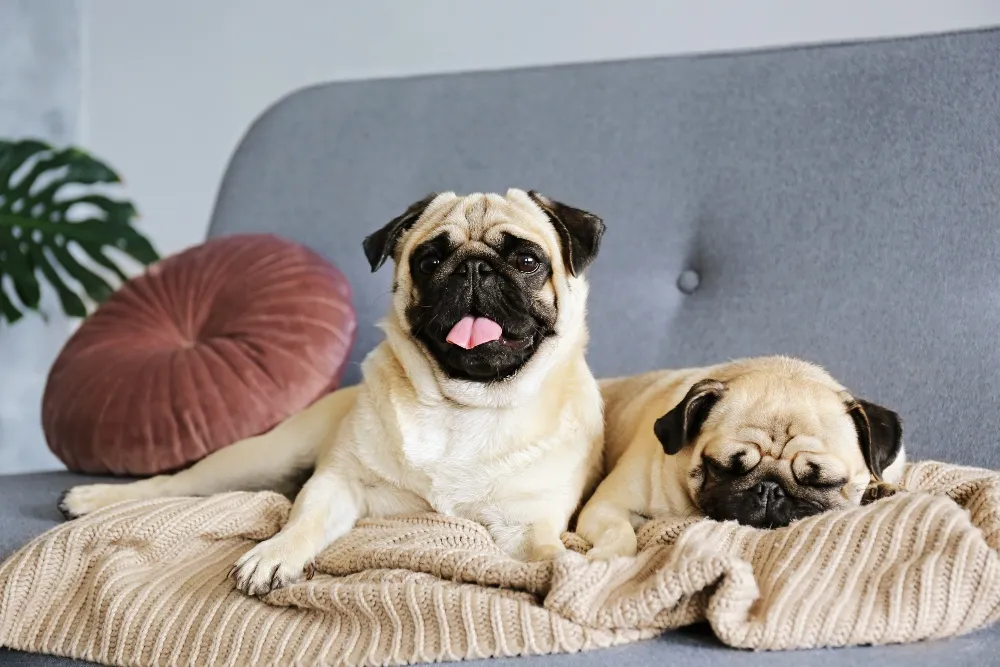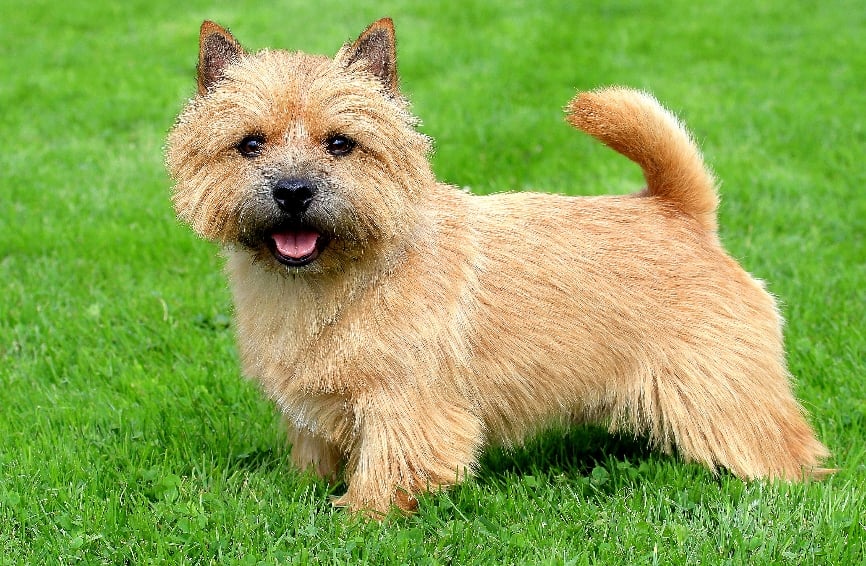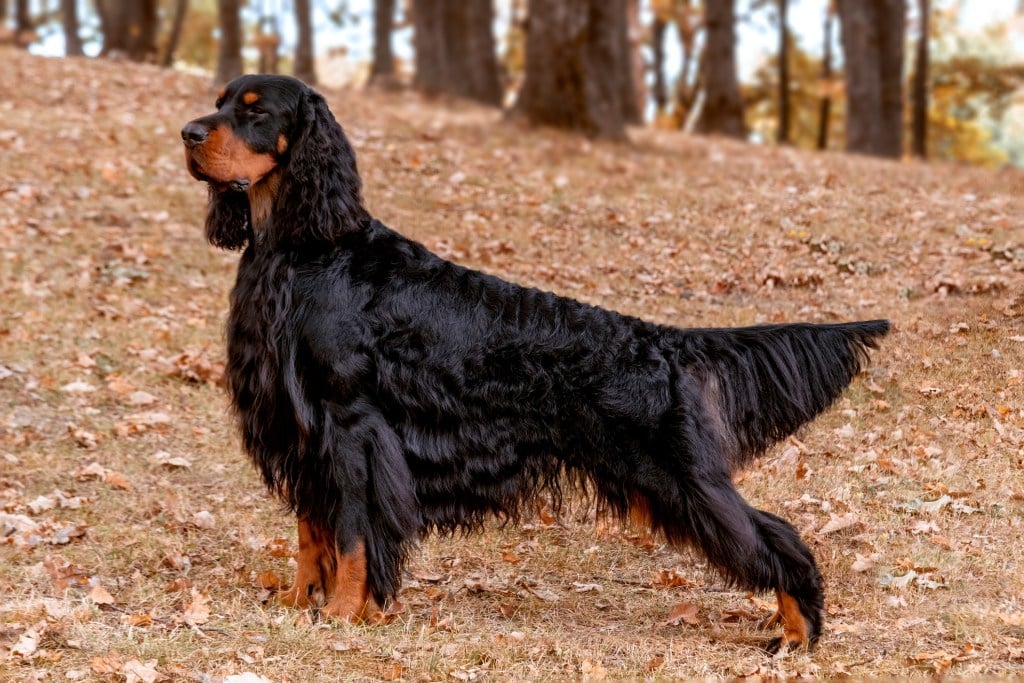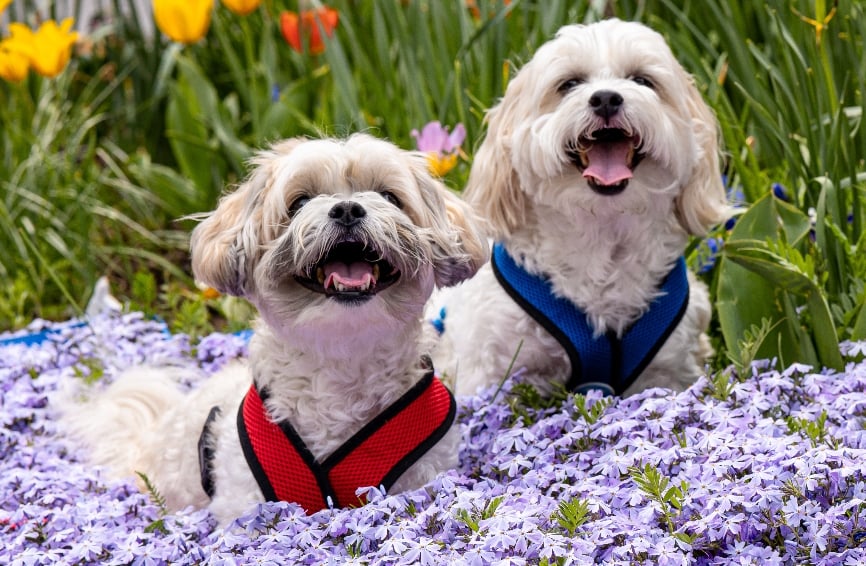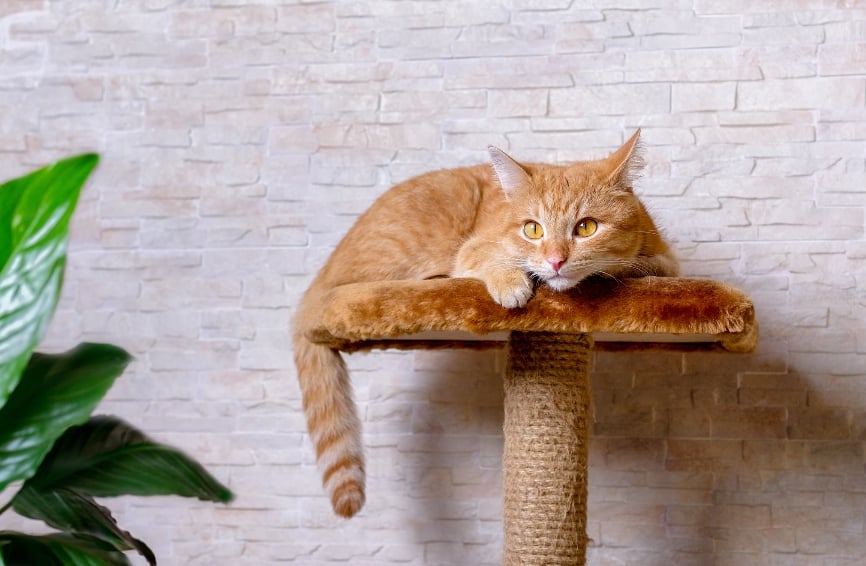Table of Contents
Introduction to Pugs
Pugs are charming and adorable little dogs that can be mischievous companions and add a whole lot of love to your life. These unique dogs have a distinctive shape and personality, and they can thrive in many different living environments. People who know and love pugs often say that they are a “lot of dog” that comes in a compact package.
If you’re looking for a sensitive and playful dog and have plenty of time to spend with a pet, a pug might be the perfect dog for you! Read on to learn more about the pug breed of dogs and how to take the best care of the pug in your household.
Size of Pugs
When fully grown, a pug should weigh between 14 and 18 pounds and stand at 10 to 13 inches tall. These dogs typically reach their adult height by about 9-10 months of age; however, some puppies continue to grow, and most will fill out a bit until they are one year old. Male pugs weigh slightly more than female pugs, so take gender into consideration with the weight averages listed below. Pugs are part of the Toy Group of dogs, but they are on the larger end of this designation and both taller and heavier than most other Toy Group dogs.
Here’s how big you can expect your pug to get as he or she gets older each month:
| Weight Chart | 3 months | 6 months | 9 months |
| Male and Female Pugs | 4-7 pounds | 7-12 pounds | 13-18 pounds |
Characteristics of Pugs
Pugs are moderately adaptable dogs that do well in small spaces and can be good pets for first-time pet parents. They are friendly and affectionate with moderate grooming needs. However, they have more than their fair share of health problems, and it can be a challenge to train a pug.
Some characteristics that stand out about pugs are that they are excellent family dogs and have charming personalities. They have been bred for their excellent dispositions and are happiest when family members are around the house to spend time with them.
As you get to know a pug’s personality, here’s what you can expect based on his or her breed characteristics:
| Breed Characteristic | Level (High, Medium, Low) |
| Affectionate with People | High |
| Good with Kids | High |
| Good with Pets | High |
| Need for Exercise | Low |
| Energy Level | Medium |
| Intelligence Level | Medium |
| Able to Be Trained | Medium |
| Amount of Barking | Medium |
| Amount of Shedding | Medium |
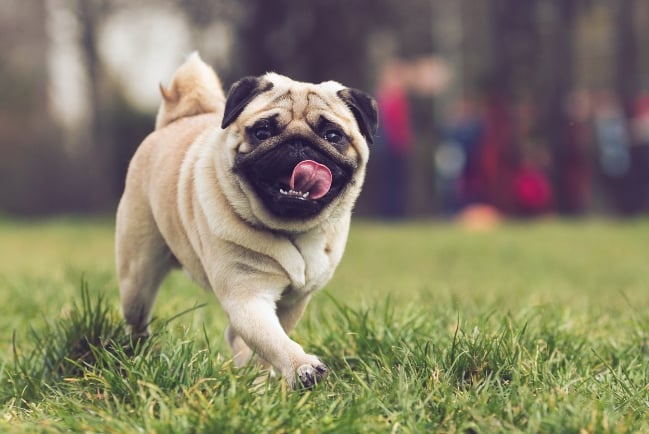
History of Pugs
The history of the pug dates back at least 2,000 years, as this is one of the most ancient breed of dogs documented in records. Some historical accounts can link pug dogs to times even before 400 BC.
Pugs were favored by Chinese emperors and cherished as treasures of the Far East. These flat-faced pups were beloved lap dogs, along with the Pekingese and shih tzu. Dutch traders discovered pugs around the 1500s, and they were introduced as a mascot for Holland’s Royal House of Orange, according to local legend. They gained popularity in England among British monarchs, as well as in Finland, France, and Spain throughout history. Everyone from Tibetan monks to the Victorian-era elite and Napoleon’s wife have welcomed pugs into their homes.
One theory about the origin of the name “pug” references the Latin word, pungus, which means “fist” since the dog’s scrunched face somewhat resembles a clenched fist. Pugs have been recognized by the American Kennel Club as a breed since 1885.
Pug Standard Information
Pugs are purebred dogs, and so there is an established breed standard for which these dogs are judged against each other at shows and competitions. In general, these dogs have a square and cobby appearance that is compact and well-muscled. The breed standard also specifies the ideal temperament of a pug, which is playful, stable, charming, dignified, outgoing, loving, and even-tempered.
Here is an overview of the breed standard information for pugs:
Head:
- Large and round with no indentation of skull
- Thin, small, and soft ears
- Dark, large, and bold eyes
- Very slightly undershot bite
- Deep and large wrinkles
- Short, blunt, and square muzzle
Neck, Topline, Body:
- Neck slightly arched and strong and thick
- Back level from withers to high tail set
- Wide chest and well ribbed up
- Tail curled tightly over hip
Forequarters:
- Strong, straight, and moderate length legs
- Shoulders moderately laid back
- Well split-up toes
- Dewclaws generally removed
Hindquarters:
- Strong and powerful hindquarters
- Legs parallel when viewed from behind
- Thighs and buttocks full and muscular
Coat:
- Fine, smooth, short, and glossy
- Neither hard nor wooly
Color:
- Fawn or black
- Contrast between color and the trace and mask
- Markings clearly defined
Gait:
- Forelegs carried well-forward
- Rear action strong and free
- Slight natural convergence of limbs
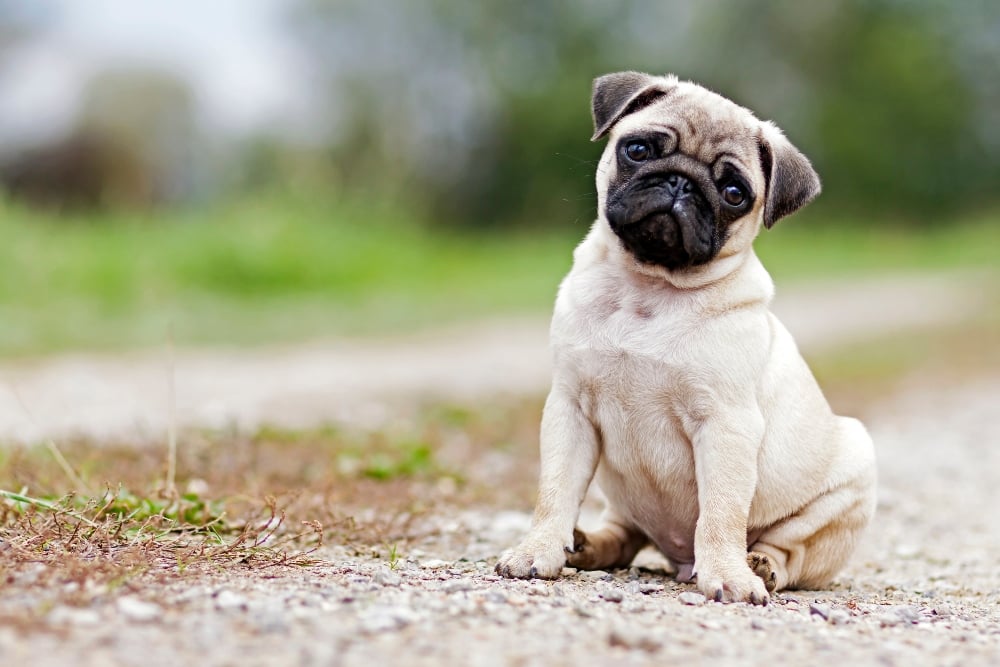
Caring for Pugs
It can be so fun taking care of a pug that it hardly feels like work much of the time. These are easy dogs to live with, but they are temperature-sensitive and do need daily exercise. It’s important to keep pugs out of the heat when the weather gets warm and only exercise them a moderate amount to prevent health problems that can arise because of their short faces.
Pugs have outgoing temperaments but should be socialized early in life so that they feel comfortable around adults, children, and other animals. These dogs love having constant companionship, so this is a great dog if you like being followed around the house and having a little cuddler in your lap or in your bed.
Here are some general tips for taking the best care of a pug:
Best Living Environments:
- Suited well for apartment living
- Do fine in houses with small backyards too
- Great around children and other pets
Type of Exercise:
- About 20 minutes of exercise daily
- Keep exercise moderate and not too intense
- Watch for signs of overheating and trouble breathing
Mental Enrichment:
- Play dates with other dogs
- Cuddle time with family members
- Food puzzles
- Don’t leave a pug home alone all day
Training Strategies:
- Can be notoriously difficult to housebreak and train
- Pugs are known to be stubborn
- Consider hiring a trainer and be extra patient during training sessions
- Positive reinforcement not punishment
- Reward with small treats and a kind voice
Grooming Tips:
- Shed a lot despite the short coat
- Daily grooming is needed including wiping out wrinkles with a damp cloth
- Brush regularly to reduce shedding
- Bathe once per month
- Trim nails regularly since pugs spend most of their time indoors
- Check eyes for redness or discharge weekly
- Brush teeth daily
Common Health Problems of Pugs
You can expect most pugs to live between 13 and 15 years. Because of their flat faces, pugs are prone to potentially serious breathing problems and overheating. Pugs also have bulging eyes that are vulnerable to dry eye syndrome, corneal ulcers, and other eye issues. Because of their genetics and breeding history, pugs can develop numerous other health conditions, especially as they age. These include brain inflammation that can lead to seizures, hip deformities, and spinal conditions. Pugs are prone to obesity too, which can make existing conditions worse or spark their onset.
These are some of the most common health issues that arise with pugs:
- Brachycephalic syndrome that leads to difficulty breathing and other health problems
- Pug Dog Encephalitis (inflammation of the brain)
- Obesity
- Eye diseases
- Legg-Calvé-Perthes disease
- Arthritis
- Luxating patellas
- Hemivertebrae (deformed bones in the spine)
- Dental issues due to pugs’ flattened faces
- Hip dysplasia
- Portosystemic shunt (a type of liver disease)
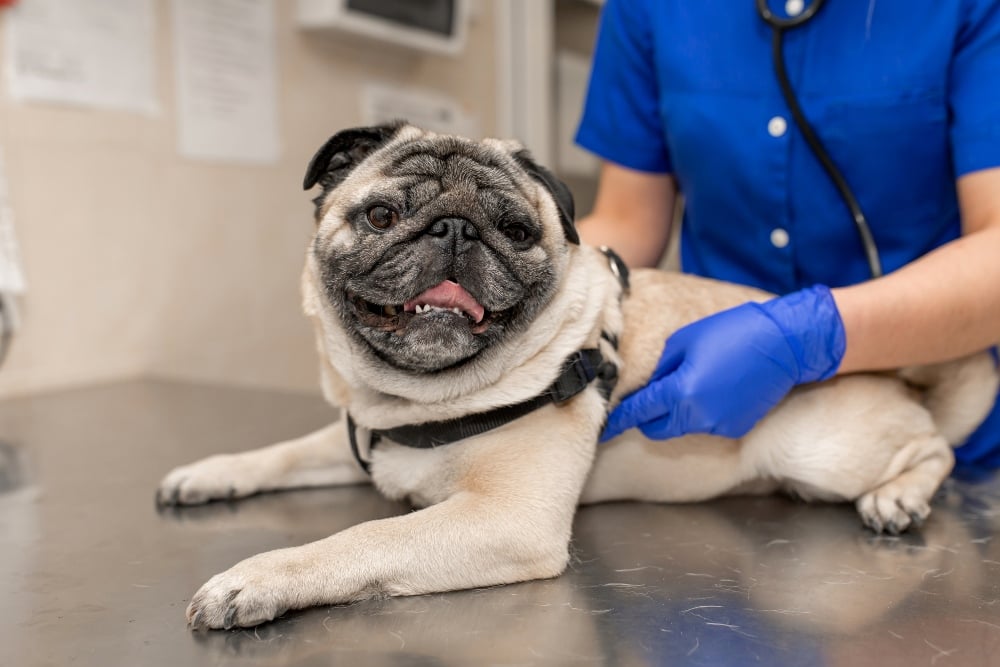
Diet and Nutrition for Pugs
Pugs are known to be greedy eaters and love to overeat if they are given the opportunity. If you overfeed your pug, you will increase the dog’s risk of obesity and potentially even shorten the dog’s lifespan because of health-related complications. Make sure you feed meals rather than leaving food out throughout the day and limit the number of treats you give to help keep your dog’s weight under control.
Most adult pugs will thrive when eating a high-quality, nutritionally complete and balanced adult dog food. Puppies should eat puppy food until they are around 10 months old. If you feed your pug homemade dog food, make sure you are working from a recipe that is designed by a veterinary nutritionist and that is appropriate for your dog’s age and health status.
Feed the amount of dog food needed to keep your pet slim. You should be able to see your pug’s waist and feel (but not see) the ribs without having to press too hard. Divide the total amount of food for the day into at least two meals for adults and three to five meals for puppies.
Some recommended commercial dog foods for adult pugs include Royal Canin Pug Adult Dry, Purina Pro Plan Savor Dry, and Wellness Complete Health Dry dog food. Good nutrition is very important for pugs to live long and happy lives. Talk to your veterinarian if you have any questions about your dog’s diet or health.
Where to Adopt or Purchase Pugs
As purebred dogs, you can often find breeders who specialize in pugs and that practice responsible breeding with health checks and compassionate care. The AKC Marketplace is a resource for finding pug puppies from AKC-registered litters.
But there are also many pug rescue organizations in the U.S. – actually dozens of groups that are committed to finding loving homes for pugs in need of a place to live. Pug Nation Rescue of Los Angeles is an example of a rescue nonprofit organization that features pup photos, bios, and even adoption events to get the word out about adoptable pugs. Meanwhile, Boogiethepug.com offers a comprehensive list of pug rescue groups by state so you that can learn more about local organizations and the pugs they are helping.
Related Breeds
Pugs certainly are unique, but there are other similar and related breeds of dogs that you might be interested in learning more about if you love pugs. Here are some other breeds to consider before bringing a purchased or adopted pug into your home.
- Boston terrier
- Japanese chin
- French bulldog
Pet Insurance for Pugs
Because of the many health issues that are common with pugs and these pups’ long lifespans of around 13 to 15 years, it is important to look into pet health insurance as early as possible. Healthy Paws offers insurance plans for pugs, with most claims processed within two days and no caps on annual or lifetime payouts. Signing your pug up for pet insurance is a great way to think about your dog’s future and reduce your family’s stress in case new accidents, illnesses, cancer, emergency situations, genetic conditions, or alternative care needs arise.
Tell us just a few details about your pug, and we’ll provide you with an instant pet insurance quote. We know how much you love your pug and want to do everything possible to protect and care for your furry friend. If you have any questions about how pet insurance for pugs works, please give us a call at 855-898-8991.
